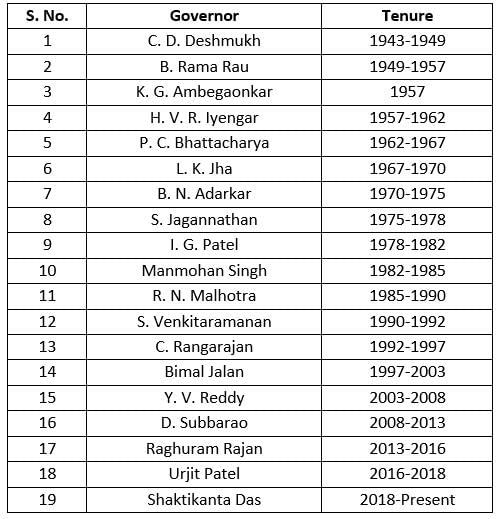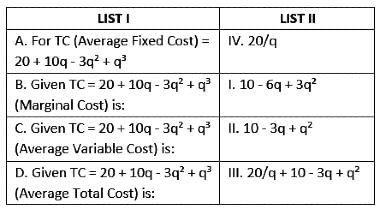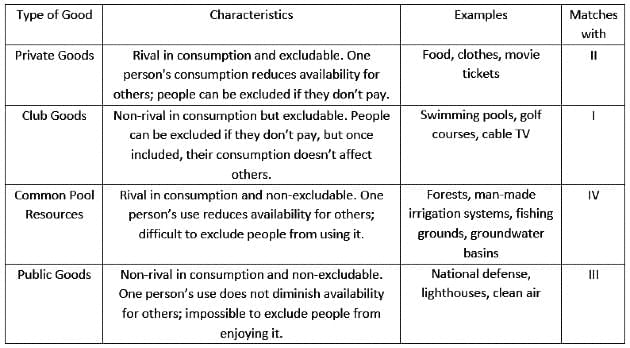CUET PG Exam > CUET PG Tests > CUET PG Economics Mock Test- 10 - CUET PG MCQ
CUET PG Economics Mock Test- 10 - CUET PG MCQ
Test Description
30 Questions MCQ Test - CUET PG Economics Mock Test- 10
CUET PG Economics Mock Test- 10 for CUET PG 2025 is part of CUET PG preparation. The CUET PG Economics Mock Test- 10 questions and answers have been prepared
according to the CUET PG exam syllabus.The CUET PG Economics Mock Test- 10 MCQs are made for CUET PG 2025 Exam.
Find important definitions, questions, notes, meanings, examples, exercises, MCQs and online tests for CUET PG Economics Mock Test- 10 below.
Solutions of CUET PG Economics Mock Test- 10 questions in English are available as part of our course for CUET PG & CUET PG Economics Mock Test- 10 solutions in
Hindi for CUET PG course.
Download more important topics, notes, lectures and mock test series for CUET PG Exam by signing up for free. Attempt CUET PG Economics Mock Test- 10 | 75 questions in 90 minutes | Mock test for CUET PG preparation | Free important questions MCQ to study for CUET PG Exam | Download free PDF with solutions
CUET PG Economics Mock Test- 10 - Question 1
Assertion (A): A lumpsum tax imposed on a monopolist cannot be shifted to the consumers.
Reason (R): The lumpsum tax becomes a part of his fixed cost and it does not affect the marginal cost of production. Consider the above statements and select the correct answer from the codes given below: Codes:
Reason (R): The lumpsum tax becomes a part of his fixed cost and it does not affect the marginal cost of production. Consider the above statements and select the correct answer from the codes given below: Codes:
Detailed Solution for CUET PG Economics Mock Test- 10 - Question 1
Detailed Solution for CUET PG Economics Mock Test- 10 - Question 2
CUET PG Economics Mock Test- 10 - Question 3
Under which Sustainable Development Goal, energy is included?
Detailed Solution for CUET PG Economics Mock Test- 10 - Question 3
CUET PG Economics Mock Test- 10 - Question 4
Given below are two statements:
Statement I: A common resource is rival and non-excludable.
Statement II: A public good is non-rival and non-excludable. In the light of the above statements, choose the most appropriate answer from the options given below:
Statement I: A common resource is rival and non-excludable.
Statement II: A public good is non-rival and non-excludable. In the light of the above statements, choose the most appropriate answer from the options given below:
Detailed Solution for CUET PG Economics Mock Test- 10 - Question 4
CUET PG Economics Mock Test- 10 - Question 5
Which of the following is consistent with the idea of expansionary fiscal policy?
Detailed Solution for CUET PG Economics Mock Test- 10 - Question 5
CUET PG Economics Mock Test- 10 - Question 6
Under the post 1991 economic policies, the Government of India sup ports
Detailed Solution for CUET PG Economics Mock Test- 10 - Question 6
CUET PG Economics Mock Test- 10 - Question 7
Arrange the following in chronological order.
(A) The Indirect Tax Enquiry Committee (Jha Committee) 1977-78
(B) Tax Reform Committee (Chelliah Committee) 1991
(C) Taxation Enquiry Commission (Matthai Commission) 1953-54
(D) The Direct Tax Enquiry Committee (Wanchoo Committee) 1970
(A) The Indirect Tax Enquiry Committee (Jha Committee) 1977-78
(B) Tax Reform Committee (Chelliah Committee) 1991
(C) Taxation Enquiry Commission (Matthai Commission) 1953-54
(D) The Direct Tax Enquiry Committee (Wanchoo Committee) 1970
Select the correct answer from the codes given below:
Codes:
Codes:
Detailed Solution for CUET PG Economics Mock Test- 10 - Question 7
CUET PG Economics Mock Test- 10 - Question 8
According to Keynesians, the primary reason money is not neutral is
Detailed Solution for CUET PG Economics Mock Test- 10 - Question 8
CUET PG Economics Mock Test- 10 - Question 9
Which statement describes the crowding-out hypothesis in public finance?
Detailed Solution for CUET PG Economics Mock Test- 10 - Question 9
CUET PG Economics Mock Test- 10 - Question 10
Marshall Lerner condition is derived based on the assumption of
Detailed Solution for CUET PG Economics Mock Test- 10 - Question 10
CUET PG Economics Mock Test- 10 - Question 11
Match List I with List II:

Choose the correct option below:

Choose the correct option below:
Detailed Solution for CUET PG Economics Mock Test- 10 - Question 11
CUET PG Economics Mock Test- 10 - Question 12
The price elasticity of demand faced by a firm in a perfectly competitive market is
Detailed Solution for CUET PG Economics Mock Test- 10 - Question 12
CUET PG Economics Mock Test- 10 - Question 13
Assume a two-country world: Country A and Country B. Which of the following is correct about purchasing power parity (PPP) as related to these two countries?
Detailed Solution for CUET PG Economics Mock Test- 10 - Question 13
Detailed Solution for CUET PG Economics Mock Test- 10 - Question 14
CUET PG Economics Mock Test- 10 - Question 15
Arrange the following former Governors of RBI in the chronological order of their tenure as Governors starting from the earliest:
(A) C Rangaswami
(B) D. Subbarao
(C) I. G. Patel
(D) Y. V. Reddy
(E) Bimal Jalan
Choose the correct answer from the options given below:
(A) C Rangaswami
(B) D. Subbarao
(C) I. G. Patel
(D) Y. V. Reddy
(E) Bimal Jalan
Choose the correct answer from the options given below:
Detailed Solution for CUET PG Economics Mock Test- 10 - Question 15
CUET PG Economics Mock Test- 10 - Question 16
Match List I with List II
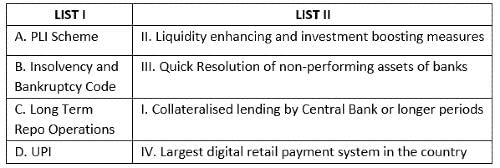
Choose the correct answer from the options given below:

Choose the correct answer from the options given below:
Detailed Solution for CUET PG Economics Mock Test- 10 - Question 16
CUET PG Economics Mock Test- 10 - Question 17
The maximum value of fiscal policy multiplier is __________ (b implies sensitivity of planned investment spending to interest rate. c implies marginal property to consume, t is marginal tax rate, k refers to sensitivity of money demand to interest rate)
Detailed Solution for CUET PG Economics Mock Test- 10 - Question 17
CUET PG Economics Mock Test- 10 - Question 18
For downward movement along the iso-quant, MRTS of Labour per unit of capital (MRTSL,K) is given by
Detailed Solution for CUET PG Economics Mock Test- 10 - Question 18
CUET PG Economics Mock Test- 10 - Question 19
Which of the following are correct regarding market structures:
A. Monopolistic competition is characterised by free entry/exit with each firm producing differentiated goods.
B. Oligopoly allows free entry.
C. Cartels are formed when firms explicitly collude and maximise joint profits.
D. Monopoly power arises when price > AC E. Competitive market does not allow free entry.
Choose the correct answer from the options given below:
A. Monopolistic competition is characterised by free entry/exit with each firm producing differentiated goods.
B. Oligopoly allows free entry.
C. Cartels are formed when firms explicitly collude and maximise joint profits.
D. Monopoly power arises when price > AC E. Competitive market does not allow free entry.
Choose the correct answer from the options given below:
Detailed Solution for CUET PG Economics Mock Test- 10 - Question 19
CUET PG Economics Mock Test- 10 - Question 20
Match List I with List II
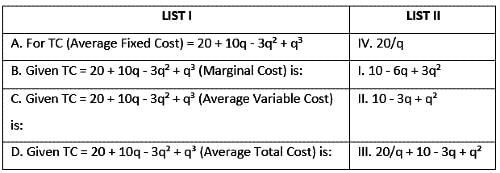
Choose the correct answer from the options given below:

Choose the correct answer from the options given below:
Detailed Solution for CUET PG Economics Mock Test- 10 - Question 20
CUET PG Economics Mock Test- 10 - Question 21
Given below are two statements: One is labelled as Assertion (A) and the other is labelled as Reason (R):
- Assertion (A): Pareto optimality implies that an allocation of resources is inefficient when it is possible. through some change in the allocation of resources to benefit at least one person without making anyone else worse off.
- Reason (R): Pareto efficiency takes into account distributive justice and compensation of people affected negatively.
In the light of the above statements, choose the most appropriate answer from the options given below:
Detailed Solution for CUET PG Economics Mock Test- 10 - Question 21
CUET PG Economics Mock Test- 10 - Question 22
Given below are two statements: one is labelled as Assertion A and the other is labelled as Reason R.
- Assertion (A): Walras' law states that the value of aggregate excess demand for all markets is zero.
- Reason (R): If (K-1) markets are in equilibrium, then the market for good K will automatically have demand equal to supply.
In the light of the above statements, choose the most appropriate answer from the options given below:
Detailed Solution for CUET PG Economics Mock Test- 10 - Question 22
Detailed Solution for CUET PG Economics Mock Test- 10 - Question 23
CUET PG Economics Mock Test- 10 - Question 24
Match List I with List II
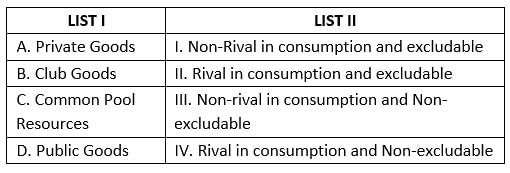
Choose the correct answer from the options given below:

Choose the correct answer from the options given below:
Detailed Solution for CUET PG Economics Mock Test- 10 - Question 24
CUET PG Economics Mock Test- 10 - Question 25
Demographic dividend refers to a rise in population
Detailed Solution for CUET PG Economics Mock Test- 10 - Question 25
CUET PG Economics Mock Test- 10 - Question 26
A firm has a production function q = A . K0.5 L1.8, where A is a positive constant. Such a production function exhibits
Detailed Solution for CUET PG Economics Mock Test- 10 - Question 26
CUET PG Economics Mock Test- 10 - Question 27
For the utility function u(x, y) = xy and given budget constrain M = pₓx + pᵧy, what is the optimum bundle of consumption of x and y?
Detailed Solution for CUET PG Economics Mock Test- 10 - Question 27
CUET PG Economics Mock Test- 10 - Question 28
If you draw a random sample of size 36 from a population whose standard deviation is 12, what will be the standard error of sample mean?
Detailed Solution for CUET PG Economics Mock Test- 10 - Question 28
Detailed Solution for CUET PG Economics Mock Test- 10 - Question 29
CUET PG Economics Mock Test- 10 - Question 30
In Harrod-Domar Model. if the growth rate of income is 3% and the capital output ratio is 6% then the saving rate must be
Detailed Solution for CUET PG Economics Mock Test- 10 - Question 30
View more questions
Information about CUET PG Economics Mock Test- 10 Page
In this test you can find the Exam questions for CUET PG Economics Mock Test- 10 solved & explained in the simplest way possible.
Besides giving Questions and answers for CUET PG Economics Mock Test- 10, EduRev gives you an ample number of Online tests for practice
Download as PDF


 are
are , we have already found the characteristic equation:
, we have already found the characteristic equation:





